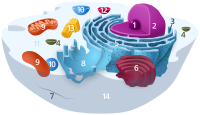
Photo from wikipedia
Bis-hydrazides 13a-h were designed and synthesized as potential tubulin inhibitors selectively targeting the colchicine site between α- and β-tubulin subunits. The newly designed ring-B substituents were assisted at their ends… Click to show full abstract
Bis-hydrazides 13a-h were designed and synthesized as potential tubulin inhibitors selectively targeting the colchicine site between α- and β-tubulin subunits. The newly designed ring-B substituents were assisted at their ends by 'anchor groups' which are expected to exert binding interaction(s) with new additional amino acid residues in the colchicine site (beyond those amino acids previously reported to interact with reference inhibitors as CA-4 and colchicine). Conformational flexibility of bis-hydrazide linker assisted these 'extra-binding' properties through reliving ligands' strains in the final ligand-receptor complexes. Compound 13f displayed the most promising computational and biological study results in the series: MM/GBSA binding energy of -62.362 kcal/mol (extra-binding to Arg α:221, Thr β:353 & Lys β:254); 34% NCI-H522 cells' death (at 10 µM), IC50 = 0.073 µM (MTT assay); significant cell cycle arrest at G2/M phase; 11.6% preG1 apoptosis induction and 83.1% in vitro tubulin inhibition (at concentration = IC50). Future researchers in bis-hydrazide tubulin inhibitors are advised to consider the 2-chloro-N-(4-substituted-phenyl)acetamide derivatives as compound 13f due to extra-binding properties of their ring B.
Journal Title: Bioorganic chemistry
Year Published: 2020
Link to full text (if available)
Share on Social Media: Sign Up to like & get
recommendations!